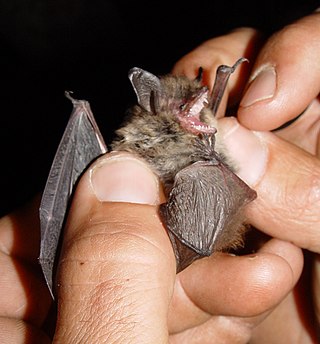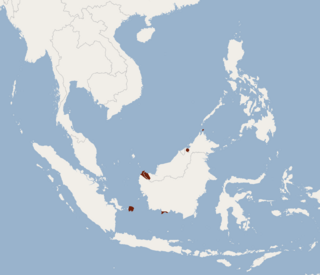
The mouse-eared bats or myotises are a diverse and widespread genus (Myotis) of bats within the family Vespertilionidae. The noun "myotis" itself is a Neo-Latin construction, from the Greek "muós and "oûs", literally translating to "mouse-eared".

The fraternal myotis is a species of vesper bat native to East Asia.

Hodgson's bat, also called the copper-winged bat or black-and-orange myotis, is a species of vesper bat in the genus Myotis, the mouse-eared bats. Favouring mountain forests, it is found throughout Central, Southeast, and East Asia, from Afghanistan to Taiwan. It is about 5 centimetres (2.0 in) long and is distinguished from most other species of bat in this range by its yellowish colouration.
The Sulawesi yellow bat is a species of vesper bat. It is found only in Indonesia.

Hardwicke's woolly bat is a species of vesper bat in the family Vespertilionidae.

The hairy-faced bat is a species of vesper bat.

The fringed long-footed myotis is a species of vesper bat in the family Vespertilionidae. It is found in China, Taiwan and Hong Kong.

The Burmese whiskered myotis or Burmese whiskered bat is a species of vesper bat. It is found in China, India, Myanmar, Laos, and Vietnam.

Myotinae is a subfamily of vesper bats. It contains three genera: Eudiscopus, Myotis, and Submyotodon. Before the description of Submyotodon and analysis of its phylogenetics, as well as a phylogenetic analysis of Eudiscopus, the only member of Myotinae was Myotis.

The Madura horseshoe bat is a species of bat from the family Rhinolophidae. Current taxonomy treats the Madura horseshoe bat as a species separate of the Sulawesi horseshoe bat and not including parvus, but Csorba et al. (2003) recognizes both as subspecies of the Sulawesi horseshoe bat. It is known only from seven specimens from Madura Island and the Kangean Islands in Indonesia, and its type locality is Soemenep, Madura Island. The species is listed as Vulnerable on the IUCN Red List, and it suffers from habitat loss due to limestone excavation and deforestation for logging and agriculture in its habitat. It is also unknown whether or not the Madura horseshoe bat lives in any protected areas. The species is cave-roosting and most likely independent of water, foraging in primary forest.

The Vordermann's pipistrelle is a species of vesper bat found in Brunei Darussalam, Indonesia, and Malaysia. It was described in 1890 by the Dutch zoologist Fredericus Anna Jentink, who named it after its discoverer, the Dutch physician Adolphe Vorderman.

Myotis indochinensis, commonly known as the Indochinese mouse-eared bat, is a species of cave-dwelling bat in the family Vespertilionidae. It is found in Vietnam and China.
The reddish myotis is a species of vesper bat. It is endemic to Taiwan.

The long-toed myotis or Taiwan long-toed myotis is a species of vesper bat endemic to Taiwan.

The orange-fingered myotis or red-painted myotis is a species of vesper bat endemic to the Philippines.

The reddish-black myotis or black-winged myotis, colloquially known as the "red bat" or "golden bat" in South Korea, is a species of vesper bat found throughout East Asia.

Peyton's myotis, also known as Peyton's whiskered bat, is a species of vesper bat endemic to India.

The Malaysian whiskered myotis or Malayan whiskered myotis is a species of vesper bat endemic to Malaysia, although it may possibly also occur in Indonesia.

The Bornean whiskered myotis is a species of vesper bat endemic to Borneo.

The long-tailed myotis is a species of vesper bat found in northern and eastern Asia.
















